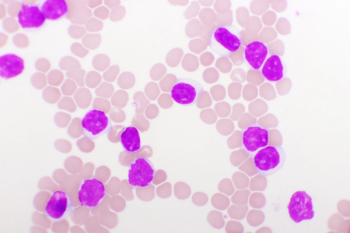
Patients with chronic lymphocytic leukemia or small lymphocytic leukemia treated with zanubrutinib, obinutuzumab, and venetoclax experienced increased rates of undetectable minimal residual disease in peripheral blood and bone marrow.

Your AI-Trained Oncology Knowledge Connection!


Patients with chronic lymphocytic leukemia or small lymphocytic leukemia treated with zanubrutinib, obinutuzumab, and venetoclax experienced increased rates of undetectable minimal residual disease in peripheral blood and bone marrow.

Arfolitixorin was granted a fast track designation by the FDA for advanced colorectal cancer based on its potential to address unmet medical needs.

DNA sequencing to detect minimal residual disease and eventual relapse was more accurate than flow cytometry for adult and pediatric patients with acute lymphoblastic leukemia who have been treated with tisagenlecleucel.

Wade Iams, MD, broke down some of the different treatment options, including lurbinectedin and topotecan, for patients with relapsed/refractory small cell lung cancer in the second episode of a 4-part small cell lung cancer podcast series.

A complete response letter has been issued to BeyondSpring Pharmaceuticals for plinabulin plus granulocyte colony-stimulating factor for the prevention of chemotherapy-induced neutropenia.

Panobinostat, which received accelerated approval by the FDA in February 2015 for patients with previously treated multiple myeloma, has had its indication withdrawn in the United States.

A combination of daratumumab, hyaluronidase-fihj, carfilzomib, and dexamethasone has been approved by the FDA for the treatment of relapsed/refractory multiple myeloma.

The FDA has requested more time to review data from 3 pivotal trials featuring pacritinib for the treatment of intermediate or high-risk primary or secondary myelofibrosis with severe thrombocytopenia, thus extending the review period for the agent’s new drug application.

Pediatric patients with KMT2A-rearranged acute myeloid leukemia who were treated with gemtuzumab ozogamicin plus standard chemotherapy experienced improved event-free survival and a reduced relapsed risk.

Patients with bladder cancer reported improvements in physical and social scores following radical cystectomy, although body image and sexual functioning scores decreased.

Patients with high-grade and low-grade brain tumors who carry the BRAF V600E mutation were treated with dabrafenib and trametinib saw clinically meaningful results.

Olaparib, which was granted priority review by the FDA, has been shown to improve invasive disease-free survival for patients with BRCA-mutated HER2-negative high-risk early breast cancer.

Encouraging responses and safety data were observed in the phase 3 SORAYA trial, which analyzed mirvetuximab soravtansine monotherapy for patients with folate receptor α–high platinum-resistant ovarian cancer who previously received bevacizumab.

Patients who were given extended 5-year treatment with letrozole plus 2 to 3 years of tamoxifen experienced an improvement in disease-free survival compared with 2 to 3 years of treatment with letrozole.

Imaging drug pafolacianine was approved by the FDA to detect ovarian cancer lesions in patients during surgery.

Men with localized prostate cancer were most likely to select treatment with radiotherapy over surgery and its associated adverse effects.

Late-stage cancer and poor outcomes for patients may occur as a result of low screening numbers during the COVID-19 pandemic.

Breast cancer survivors who are minorities or medically underserved appear to experience a benefit in health-related quality of life after taking part in a community-based physical activity program.

As the year 2021 comes to a close, CancerNetwork® reviews ongoing clinical research and upcoming innovations in the non–small cell lung cancer space.

Don Dizon, MD, FACP, FASCO, discusses the need to improve treatment strategies for transgender patients with cancer.

Investigators identified an association between the early expansion of Medicaid and a reduction in cancer-related mortality.

One in 3 nurses do not feel emotionally health, a large number of whom have experienced trauma due to the COVID-19 pandemic and no longer wish to be in their job position.

Aparna Parikh, MD, MS, discusses how her early experiences with physical fitness shaped her current relationship with exercise.

Investigators have identified a gap in end-of-life care among patients with cancer who are dual eligible for Medicare and Medicaid.

A secondary analysis of a clinical trial indicated that women who were human immunodeficiency virus–positive and underwent loop electrosurgical excision procedure for cervical intraepithelial neoplasia had an increased likelihood of clearing high-risk human papillomavirus than women who underwent cryotherapy.

The Build Back Better Act could increase drug and related expenses could eventually lead to the closure of independent oncology practices.

CancerNetwork® spoke with Allyson J. Ocean, MD, Diane M. Simeone, MD, Manuel Hidalgo Medina, MD, PhD, and Andrew E. Hendifar, MD, about their recent research into the treatment of pancreatic cancer.

Diane Simeone, MD, spoke to the need to determine which patients are at risk of developing pancreatic cancer, the importance of early detection, and challenges that need to be addressed in order to improve survival.

Patients with stage IV breast cancer who received a systemic therapy plus surgery experienced a higher survival benefit than those receiving systemic treatment alone.

CancerNetwork® sat down with Hossein Borghaei, DO, MS, to talk about keeping track of conference and journal updates to help build and maintain knowledge around lung cancer.